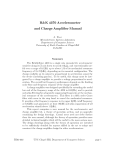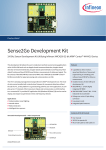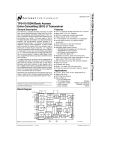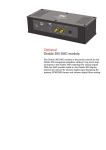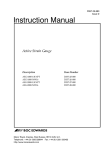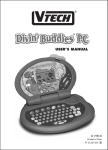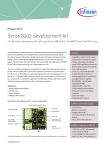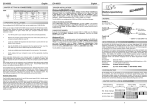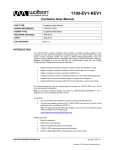Download EUREKA Timecode Reader PDF Datasheet
Transcript
EUREKA E1206 EUREKA: Longitudinal Time Code Codec IC EUREKA is the first of a series of integrated Time Code related devices developed by Hinton Instruments to meet the requirements of the audio and video industries for high performance reading and generation of SMPTE and EBU Time Code signals. EUREKA has been designed as a Coder/Decoder to translate FM encoded Time Code to and from separate Data and Clock signals suitable for a general purpose USART in synchronous mode. Although orientated towards the Zilog Z8530 SCC and its derivatives (including Z80SIO, Z181 and Z182) any USART with Bisync capability may be used. Particular attention has been paid to allow interfacing to Macintosh compatible MiniDIN serial ports and also for microprocessor-less applications. Many useful status signals are provided as well as two onboard crystal oscillators requiring only the addition of passive components. The Codec/USART combination has several advantages over conventional bus interfaced devices. It is less complicated and so more reliable and cheaper than integrating the whole frame register and then interfacing to a generalised bus and interrupt structure. As microprocessors get faster and more highly integrated EUREKA will not be rendered obsolete. EUREKA is implemented in 1 micron CMOS FPGA technology which is second sourced and widely available. There are and will be no problems in supplying any quantity from one to thousands and no concerns about future availability, unlike single sourced ASICs. Software support and customised versions can be provided if required. EUREKA has the following features: • Reads Longitudinal Time Code in the range 1/100th to 300 times playspeed (in practice limited by analogue circuitry and signal levels). • Decodes Time Code into signals suitable for clocking into USART or shift registers directly. • Encodes Time Code NRZ data generated by USART or counters into FM signal. • Provides Oscillators and Dividers configurable in several useful ways. • Provides pulses for Frame Sync word recognition and Change of Direction. • Provides status of Direction and Slow Code. • Provides clock at Eighth Frame rate for use in sub-frame accurate automation. • Low Power consumption. • 44 pin PLCC package for small size and surface mounting or socketing. Evaluation samples and application notes £45GB, £30GB/10+, £20GB/100+(+VAT in EEC). Scheduled quantities, single-product or multi-product licences negotiable. For further information contact Graham Hinton: Tel: Int + 44 1373 451927 EUREKA E1206 Specification General Description EUREKA comprises the following sections: Master Oscillator (normally used with 12.288MHz crystal) with ÷2, ÷4, ÷6, ÷8 and ÷128 outputs. Auxiliary Oscillator with ÷2 (squarewave)output. General purpose Divide by 2 stage. FM Encoder stage for Time Code Generation. Selectable Bit Clock Divider for Digital Audio, SMPTE, EBU and Film rates. High performance wideband Time Code Reader Data/Clock Extractor with Frame Sync Word Recogniser and status outputs. This stage has superior detection and locking characteristics for coping with the extreme demanding requirements of jog editing and video fast forward. EUREKA requires only the discrete oscillator components and analogue line buffering to make a complete Time Code Reader providing signals suitable for clocking into either a frame register or a USART. A Time Code Generator may be made by driving from a hardware frame counter or by using a USART. (Suitable software is required for USART support and Z8530 examples in Z80 and 68000 assembler are available.) Electrical Specifications EUREKA is implemented in Actel ACT1 technology and all manufacturer’s commercial (0 to +70°C) range specifications apply. Input and output signal levels are compatible with standard TTL and CMOS specifications. Improvements to the technology will be followed and industrial or military range components are available. Absolute Maximum Ratings Vcc Vi Vo Iio fosc DC Supply Voltage Input Pin Voltage Output Pin Voltage Output Sink/Source Current Oscillator Crystal Frequency -0.5 to +7.0 Volts -0.5 to Vcc+0.5 Volts -0.5 to Vcc+0.5 Volts ±20mA ≤20MHz Recommended Reading ANSI/SMPTE 12M-1986. The Time Code Handbook - Cipher Digital, Inc. SCC User’s Manual - Zilog, Inc. This specification and the information presented in this document may change without notice in the interests of continuing product improvement. While every effort is made to make this document accurate Hinton Instruments cannot accept any responsibility for the interpretation of the information provided or any liability for any injury, loss or damage, direct or consequential, caused by application or inability to use the equipment or information provided. Oldford, Frome, Somerset. BA11 2NN. England Tel: Int + 44 1373 451927 email: [email protected] Website: http://www.hinton-instruments.co.uk/ EUREKA E1206 Data Sheet Functional Block Diagram CLK/2 CLK/4 CLK/6 CLK/8 CLK/128 DTR XTAL EXTAL Oscillator & Timing SLOWCODE Mux /RTxC MR TCCLK CASCADE Data/Clock Separator TCIN FRAMESYNC Sync Detector DIRECTION CHANGE FRAME/8 TCDATA SEL0 XTAL2 EXTAL2 Auxiliary Oscillator SEL1 OSC2 DIVIN Programmable Divider DIVOUT TXDATA CLKx2 ÷2 FM Encoder CLKx1 TXCLK TCOUT EUREKA E1206 Data Sheet Pin Configuration Master Timing /MR Input, active Low XTAL EXTAL Output Input CLK/2 CLK/4 CLK/6 CLK/8 CLK/128 Output Output Output Output Output Time Code Reader TCIN Input TEST1 Output TEST2 Output TCDATA Output MASTER RESET. Connect to system power on reset signal. Disables master oscillator and resets derivative counters, but does not effect Auxiliary Oscillator or FM Encoder. May be deasserted, all circuitry will be in a defined state after receiving two edges on TCIN. Drive for Master Oscillator Crystal. Use recommended circuit. Connect to 12.288MHz Crystal or external clock in the range 6 to 20 MHz. Altering the frequency will effect the minimum and maximum Time Code rates proportionally. All following frequencies assume 12.288MHz. 6.144MHz 3.072MHz 2.048MHz 1.536MHz 96.0KHz Connect from signal preconditioner and comparator. See preferred circuit. Pulse of CLK/8 period duration following every edge of TCIN. Shows input signal risetime and noise are satisfactory. Pulse of CLK/2 period duration marking Bit Cell boundary, Shows correct operation of Data/Clock Separator on the incoming signal. Separated Time Code Data. Zero for first half of Bit Cell, TRUE for the second half. Latch with the rising edge of TCCLK at 75% of Bit Cell. See CASCADE. EUREKA E1206 Data Sheet TCCLK Output DTR /RTxC Input, level Output Separated Time Code Bit Clock. High for last 25% of Bit Cell, tracking second highest frequency present in TCIN. Selector for /RTxC clock multiplexer. USART Clock source: 3.072MHz when DTR = Low (divides for standard fixed rates), TCCLK (extracted clock) when DTR = High. Time Code Status FRAME/8 Output Squarewave synchronised to Time Code Frame. The first 5 bit cells are low, the next five high, etc. for each 80 bit Frame. May be used for sub-frame timing in Automation systems, MIDI Time Code converters, etc. FRAMESYNC Output, High pulse Indicates Frame synchronisation for one bit cell period. CHANGE Output, High pulse Indicates that the direction has changed between two Sync Words e.g. manual edit jogging or tape splice. DIRECTION Output, level Low = Forwards, High = Reverse. Valid after FRAMESYNC low going edge. CASCADE Output NRZ Data output from Frame Word Recogniser. May be used to feed a shift register for frame data latching. Use with DIRECTION, TCCLK and FRAMESYNC. SLOWCODE Output, active Low Asserted when TCIN has not changed for over 42ms (approximately playspeed/100) indicating that the timecode signal is extremely slow or has stopped. TEST5 Output Internal counter squarewave. Do not use. General Purpose XTAL2 EXTAL2 Output Input OSC2 Output CLKx2 Input CLKx1 Output Time Code Generator Encoder TxCLK TxDATA TCOUT Input Input Output Bit Clock Rate Divider DIVIN Input DIVOUT SEL1, SEL0 Output Inputs Drive for Auxiliary Oscillator crystal. Connect to 7.3728 MHz crystal or external clock. Tie to Vcc or Gnd if not used. Auxiliary Oscillator divided by two: 3.6863MHz squarewave. Useful for all standard Baud rates, including 115.6k and 57.6, as well as Time Code. Transmit clock divider or general purpose divide by two stage. Normally used to square DIVOUT or another divider. 50% duty cycle. Connect to TxCLK and USART Transmit clock input. Must be 50% duty cycle for correct FM encoding. NRZ synchronous serial data from USART. FM encoded Time Code output signal to analogue line driver stage. Clock frequency for division by 1, 20, 24 or 25. Normally 96kHz for standard Time Code rates. Pulse waveform at nominal double bit rate. 00 = divide by 1: 96kHz (Digital Audio). 01 = divide by 20: 4.8kHz (SMPTE). 10 = divide by 24: 4.0kHz (EBU). 11 = divide by 25: 3.84kHz (Film). EUREKA E1206 Data Sheet Bit Timing: “0” “0” “1” “1” “0” “1” TCIN TEST1 TCCLK TCDATA Bit Cell NOTES: 1) TCIN rise/fall time = 500ns maximum. 2) Rising edge of TCCLK is at 75% of previous Bit Cell period. Use this transition to latch TCDATA. 64 TCIN 79 0 SYNC WORD FRAMESYNC DIRECTION FRAME/8 Frame Timing (Forwards): NOTES: 1) FRAMESYNC width = 1 Bit Cell. 2) FRAME/8 period = 10 Bit Cells synchronised to Frame Boundary. 63 64 79 0 SYNC WORD EUREKA E1206 Data Sheet Transmit FM Encoding Notes: TXCLK must have 50% duty cycle and TXDATA must change on the rising edge of this clock. Some USARTs may use the falling edge of the transmit clock to transfer out data in which case an external inverter will be required. EUREKA E1206 Data Sheet Crystal Oscillators EUREKA has two oscillators, Main and Auxiliary, which may operate at any frequency up to 20MHz by adding the following circuit across the XTAL(2)and EXTAL(2) pins. Keep the components close to the IC pins with a good ground trace and do not take other signals through that part of the board layout. One of the capacitors may be changed to a trimmer type if higher precision than the crystal tolerance is required. Alternatively, EXTAL may be used to input an external clock. Loading XTAL will alter the oscillator frequency, so only subdivisions should be used as outputs to other circuitry or test equipment. The Main oscillator is used internally to derive all timing which is nominally based on 12.288MHz, but may be any convenient value in the range 6 to 20 MHz in which case all dependent specifications change pro rata. The Auxiliary oscillator is independent and may be used to conveniently generate another required frequency standard e.g. 7.3728MHz for all standard RS232 rates up to 115.6kBaud. If not used, connect the EXTAL2 pin to Gnd or Vcc. The total power dissipation is proportional to the oscillator frequencies. Analogue Time Code Input An input stage is required to translate the external line signal into CMOS compatible levels. This recommended circuit uses only one dual operational amplifier IC to convert either a balanced or single ended Time Code signal and operates from a single 5V power rail. The LinCMOS amplifier outputs can drive rail to rail, making it also suitable for use as the comparator. Other types may be substituted provided that similar specifications are met. The shown circuit is biased to half the 5V power rail and comprises a balanced to single ended EUREKA E1206 Data Sheet amplifier with x10 gain followed by a comparator with hysteresis. At normal recording levels the amplifier is normally saturated and the sensitivity is down to -30db inputs. Tape particle dropout is effectively removed by the comparator as the signal has to cross the zero level (2.5V)to change state. Adjusting the amount of hysteresis will also effect the lowest signal level detected. Many Time Code readers suffer from insufficient attention to the design of this stage. When tape is being hand edited the input level is lower proportionally to the speed and an input stage that is only sensitive down to -6db will only be able to digitise down to half playspeed. Most professional timecode recording uses levels of -4db on tape which becomes 0db at standard line level, adjust the 10k input resistors to suit other levels. Preserving signal polarity is not necessary. Interfacing to discrete hardware A hardware Frame Register may be constructed to capture the Timecode Frame. A 64 bit shift register is needed to store the data after the 16 bit Sync Word recogniser that is included within EUREKA. The CASCADE data output should be used and clocked in on the rising edge of TCCLK. If reading in reverse is required the shift register will have to be a bidirectional type, otherwise clocking should be gated with the DIRECTION signal. The contents of this register should be loaded into a storage register on the rising edge of FRAMESYNC where it will remain constant until the next Frame Sync. Data is only valid if there are exactly 80 bit cells between Frame Syncs and the Direction has not changed, any other states are indicative of a change of direction (e.g. jog editing) or tape splices or dropout. The CHANGE signal may be used to disable acting on the data until resynchronisation is achieved. Interfacing to a USART EUREKA may be used with any USART capable of BiSync synchronous communications. These include the Zilog Z80-SIO and Z8530 SCC and their variations in many integrated forms. The USART should be used in NRZ mode with EUREKA providing both the receiving data/clock separation and the transmitting encoding. A separate drawing is attached showing a typical connection with Z80 family peripherals. TCDATA is clocked into the USART RxD by the rising edge of TCCLK and the various pulses and levels should be connected as required to either the modem handshake inputs or other ports to generate suitable interrupts. SLOWCODE and CHANGE are important status changes so the CTS and DCD handshake pins are appropriate for a rapid response. DIRECTION and FRAMESYNC may be optionally connected to a parallel port, but this information may be obtained from the incoming data. In the example TCCLK and FRAME/8 are also taken to counter/timer channels. The separated EUREKA E1206 Data Sheet bit clock is divided by (say) 83 so that if this ever reaches zero before a frame sync the frame data is discarded. The counter is restarted on every valid frame sync. FRAME/8 is useful for synchronising other events to sub-frame accuracy e.g. MIDI Time Code (MTC) has to be transmitted on quarter frames such that the end of the second byte is coincident with the quarter frame boundary. For Timecode generation the transmit clock must be 50% duty cycle for correct FM encoding. EUREKA contains the necessary dividers to provide the clocks for SMPTE, EBU and Film rates and an FM encoder stage. The example circuit shows a typical connection. Software support Timecode is very similar in structure to BiSync data blocks with one exception - the block is of infinite length. The Syncword recognition feature of a USART is used to establish byte synchronisation, thereafter an infinite block is received or sent by software. Before synchronisation the receiver should be set to “hunt” mode where it is waiting for a two byte sync word to occur. The Sync word contains the direction information, i.e. it is symmetrical and unique apart from 1 bit, so if more than 80 clocks are received without a sync the word should be reprogrammed for the opposite direction. Once a timecode block has started the data must be read in every byte under interrupt control and assembled into frames by software paying attention to the direction. Every ninth and tenth byte must be checked to be the same syncword as programmed and if not this indicates that a direction change, splice or tape dropout may have occurred and the receiver should be set back to hunt for the next sync. The eight data bytes are only valid if they occur between two sync words and then they should be checked for consecutive legal time codes. Only dropframe code has a bit set to indicate this, all other rates have to be deduced by checking the frame overflow or underflow count. i.e. if non- dropframe-and a frame number of 27 is found it must be 30fps, but is a frame number of 21 is found the rate cannot be determined until frame 24 or frame 25. Care should be taken about handling the parity bit. As many pieces of “professional” equipment do not generate this at all or incorrectly it is best ignored. When generating timecode a Syncword is sent by the USART and then every following byte including syncwords is sent by software responding to a transmit buffer empty interrupt. The software will fill the USART’s transmit FIFO so will get ahead of the true time. If other events are to be synchronised with the frame the transmit clock should be counted off. When generation is stopped a BiSync CRC will normally be automatically sent by the USART. This would not normally cause any problems as the code would be past the area of normal interest and no reader would recognise it, but consideration should be taken on disabling the output circuitry or switching it to regenerate incoming timecode depending on the application. EUREKA E1206 Data Sheet Speed limiting The SLOWCODE status output indicates that incoming timecode is slower than 100 times less than normal playspeed. At these speeds it is unlikely that the signal from tape would be reliable or constant enough to be used correctly. When receiving from a video machine which can output timecode while in fast forward or rewind-very fast speeds may result than produce a large interrupt load. The following circuitry may be used to limit reading to a speed no greater than double normal playspeed: The time constant of the monostable should be set for the maximum timecode rate that needs to be followed. Separated clocks faster than this period will cause the Too Fast latch to be set. This signal may be used to disable the reading software and may also be gated with the Slowcode signal to create a valid speed window. PCB Layout It is recommended to place a decoupling capacitor between the Vcc and Gnd pins on each side of the PLCC package. If this is not possible no less than two on opposite sides should be used. Technical Support Hinton Instruments has provided LTC hardware and software in different forms for various manufacturers. If you wish to discuss your EUREKA application or customisation please contact: by email: [email protected] or by telephone: Int + 44 1373 451927













